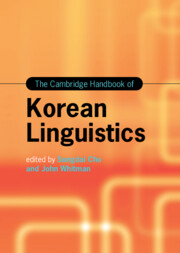Book contents
- The Cambridge Handbook of Korean Linguistics
- Cambridge Handbooks in Language and Linguistics
- The Cambridge Handbook of Korean Linguistics
- Copyright page
- Contents
- Figures
- Tables
- Contributors
- Preface
- Acknowledgments
- Abbreviations
- Part I Korean Overview
- Chapter 1 Introduction
- Chapter 2 Phonology: An Overview
- Chapter 3 Overview of Chapters on Syntax
- Chapter 4 On the Centrality of Korean in Language Contacts in Northeast Asia
- Chapter 5 Politeness Strategies in Korean
- Chapter 6 Korean Kugyŏl
- Part II Phonetics and Phonology
- Part III Morphology and Syntax
- Part IV Semantics and Pragmatics
- Part V Sociolinguistics and Psycholinguistics
- Part VI Language Pedagogy
- Index
- References
Chapter 2 - Phonology: An Overview
from Part I - Korean Overview
Published online by Cambridge University Press: 30 September 2022
- The Cambridge Handbook of Korean Linguistics
- Cambridge Handbooks in Language and Linguistics
- The Cambridge Handbook of Korean Linguistics
- Copyright page
- Contents
- Figures
- Tables
- Contributors
- Preface
- Acknowledgments
- Abbreviations
- Part I Korean Overview
- Chapter 1 Introduction
- Chapter 2 Phonology: An Overview
- Chapter 3 Overview of Chapters on Syntax
- Chapter 4 On the Centrality of Korean in Language Contacts in Northeast Asia
- Chapter 5 Politeness Strategies in Korean
- Chapter 6 Korean Kugyŏl
- Part II Phonetics and Phonology
- Part III Morphology and Syntax
- Part IV Semantics and Pragmatics
- Part V Sociolinguistics and Psycholinguistics
- Part VI Language Pedagogy
- Index
- References
Summary
Chapter 2 discusses some of the most salient and yet persistently controversial and significant phenomena in Korean phonology: lenis obstruent voicing, stop neutralization, consonant cluster simplification, consonant assimilation, consonantal fortition, Saisiot, vowel deletion and insertion, vowel devoicing and assimilation, monophthongization, vowel harmony, and sound symbolism. The chapter focuses on the Seoul Standard Dialect. One salient and recurrent theme is the theoretical issue of the relative strength of each sound, both inherent and in its environment. Some sounds are held to be “stronger” than others; we see that these sounds are exploited not only in sound symbolism but also in the application or non-application of certain rules. Boundaries play a significant role in Korean phonology and are analyzed as prosodic units in contemporary analyses. The Korean-specific basis of articulation, particularly obligatory unreleasing, results in many interesting weakening effects, including consonant cluster simplification, various assimilatory phenomena, and various consonant and vowel insertions by backward generalizations.
Keywords
- Type
- Chapter
- Information
- The Cambridge Handbook of Korean Linguistics , pp. 17 - 62Publisher: Cambridge University PressPrint publication year: 2022



